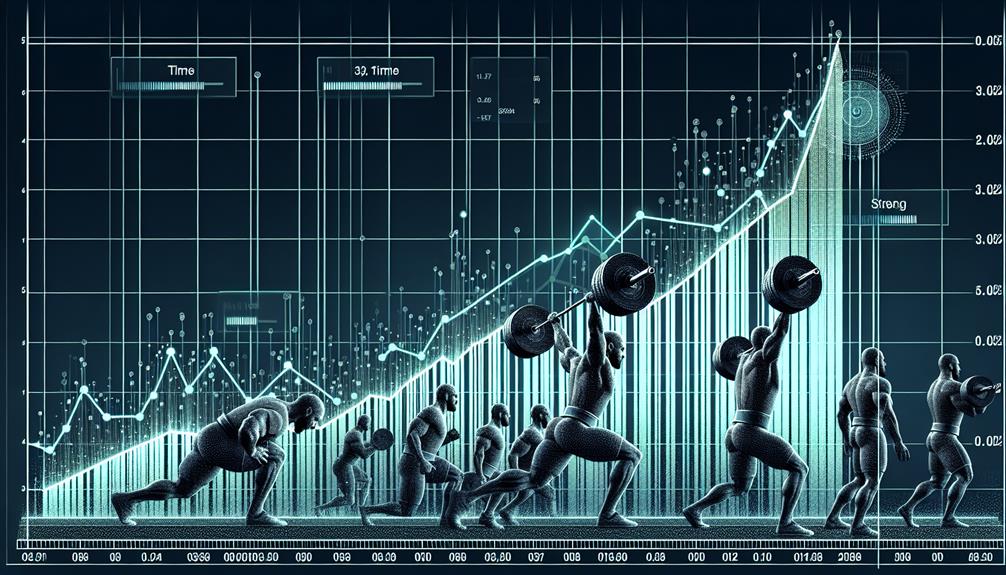In the realm of powerlifting, strength is the currency that speaks volumes. It represents your dedication, discipline, and determination to push your limits. But how do you truly measure progress in your strength journey? This is where strength metrics come into play. They act as guideposts, revealing the tangible results of your hard work and allowing you to navigate the path towards your goals. But which metrics should you focus on? How can you track your progress effectively? And most importantly, how can you use these metrics to optimize your training? These questions will be answered as we delve into the world of strength metrics in powerlifting.
Key Takeaways
- Strength metrics are valuable tools in powerlifting for tracking progress, identifying weaknesses, and preventing injuries.
- Key strength metrics in powerlifting include the One Rep Max (1RM), Wilks Score, and Total.
- Regularly tracking and comparing strength metrics within weight classes helps assess performance and strive for consistent growth.
- Strength metrics play a crucial role in setting realistic and measurable goals, optimizing training programs, and staying motivated throughout the training journey.
The Importance of Strength Metrics
Strength metrics play a crucial role in powerlifting, providing valuable insights into your progress, performance, and potential for improvement. These metrics not only help you track your gains and identify areas of weakness, but they also play a significant role in injury prevention and mental well-being.
One of the key benefits of strength metrics in powerlifting is their role in injury prevention. By monitoring your strength levels and tracking your progress over time, you can identify any imbalances or weaknesses that may increase your risk of injury. For example, if you notice a significant discrepancy in strength between different muscle groups, you can focus on exercises that target the weaker areas to prevent potential injuries.
Additionally, strength metrics have a profound impact on your mental well-being. When you see measurable improvements in your strength numbers, it boosts your confidence and motivates you to continue pushing yourself. Setting goals based on these metrics and achieving them not only gives you a sense of accomplishment but also helps alleviate stress and anxiety associated with training. Furthermore, tracking your progress allows you to celebrate your successes, no matter how small, which can have a positive impact on your overall mental state.
Key Strength Metrics in Powerlifting
To accurately assess your progress and performance in powerlifting, it is essential to track and analyze key strength metrics. These metrics are commonly used in powerlifting competitions to evaluate an athlete's strength and determine their ranking. By focusing on improving these metrics during your training, you can enhance your overall performance and achieve your goals in the sport.
Here are three common strength metrics in powerlifting competitions:
| Metric | Description | Example Exercise |
|---|---|---|
| 1RM (One Rep Max) | The maximum amount of weight you can lift for one repetition of an exercise | Squat, Bench Press, Deadlift |
| Wilks Score | A formula used to compare the strength of powerlifters of different body weights | N/A |
| Total | The sum of your best lifts in each of the three powerlifting exercises | Squat + Bench Press + Deadlift |
Improving these strength metrics requires a structured and progressive training program. Here are some tips to enhance your strength in powerlifting:
- Focus on compound exercises: Compound exercises like squats, deadlifts, and bench presses engage multiple muscle groups and promote overall strength development.
- Implement progressive overload: Gradually increase the weight, volume, or intensity of your training to continually challenge your muscles and stimulate growth.
- Prioritize rest and recovery: Allow your muscles to recover between training sessions to prevent overtraining and optimize strength gains.
Tracking Progress With Strength Metrics

When tracking your progress in powerlifting, utilizing strength metrics is crucial for accurately assessing your performance and making informed training decisions. Strength metrics provide objective data that can help you measure your progress over time and identify areas for improvement. One of the key benefits of using strength metrics is injury prevention. By tracking metrics such as your one-rep max and volume load, you can monitor your training intensity and volume to ensure that you are not overreaching or risking injury. This information can help you adjust your training program and prevent overtraining or pushing yourself too hard.
In addition to injury prevention, strength metrics also allow you to compare your progress across different powerlifting weight classes. Powerlifting weight classes are based on body weight, and comparing strength metrics within your weight class can give you a clear understanding of how you are performing relative to others in your category. It can also help you set realistic goals and benchmarks for your training. By monitoring your progress using strength metrics, you can track improvements in your lifts and strive for consistent growth and development.
Setting Goals With Strength Metrics
Utilize strength metrics to set clear and measurable goals for your powerlifting training. Setting realistic goals is an essential part of any training program as it provides direction and motivation. By tracking performance using strength metrics, you can objectively measure your progress and make informed decisions about your training.
When setting goals with strength metrics, it is important to be realistic. Consider your current strength level, training frequency, and any limitations or constraints you may have. Set goals that are challenging but attainable, taking into account factors such as your body type, age, and training experience. This will help you stay focused and motivated throughout your powerlifting journey.
Tracking performance is crucial in powerlifting as it allows you to monitor your progress over time. Strength metrics such as one-rep max (1RM), total weight lifted, and repetitions achieved can provide valuable insights into your training effectiveness. By regularly assessing your performance, you can identify areas of improvement and adjust your training accordingly.
To set effective goals with strength metrics, establish specific targets that are measurable and time-bound. For example, instead of aiming to "get stronger," set a goal to increase your 1RM bench press by 10 pounds within the next three months. This provides a clear objective and a timeframe for achievement.
Using Strength Metrics for Training Optimization

Using strength metrics allows for the optimization of training by providing objective data to assess performance and make informed decisions. By tracking and analyzing strength metrics, you can effectively design and modify your training program to ensure maximum gains while minimizing the risk of injury. Here are three ways in which strength metrics can be used for training optimization:
- Role of strength metrics in injury prevention:
- Monitoring and tracking strength metrics can help identify any imbalances or weaknesses in your muscles, which can increase the risk of injury. By addressing these weaknesses through targeted exercises and adjustments to your training program, you can reduce the likelihood of getting injured.
- Strength metrics can also help you determine if you are overtraining or pushing yourself too hard. By monitoring metrics such as fatigue levels, recovery times, and performance plateaus, you can make necessary adjustments to your training volume and intensity to prevent overuse injuries.
- Comparing strength metrics across different training programs:
- By comparing your strength metrics over time, you can assess the effectiveness of different training programs or methodologies. This allows you to identify which approaches are yielding the best results for you and make informed decisions about the direction of your training.
- Comparing strength metrics across different programs can also help you identify areas where you may need to focus your efforts. For example, if you notice that your squat strength is lagging behind your bench press and deadlift, you can adjust your training to prioritize squatting exercises and bring it up to par with the other lifts.
- Fine-tuning training variables:
- Strength metrics provide valuable feedback that can help you fine-tune various training variables such as exercise selection, volume, intensity, and rest periods. By analyzing metrics like one-rep max, volume load, and rate of perceived exertion, you can make precise adjustments to your training program to optimize your progress.
- For example, if you find that your one-rep max has plateaued for a particular exercise, you can experiment with different training variables such as changing the rep range, adjusting the intensity, or incorporating variations of the exercise to break through the plateau and continue making progress.
Frequently Asked Questions
What Are Some Common Mistakes to Avoid When Tracking Strength Metrics in Powerlifting?
Don't fall into the trap of relying solely on one metric to track your strength progress in powerlifting. Make sure to use proper form while testing strength to get accurate measurements.
Are There Any Alternative Strength Metrics That Can Be Used in Addition to the Ones Mentioned in the Article?
There are alternative measures that can be used in addition to the ones mentioned in the article. These measures have their own limitations and benefits. Implementing them may pose challenges in data analysis techniques and comparison with other sports. However, they can have a significant impact on training strategies, reliability, validity, psychological factors, and practical applications.
How Frequently Should One Retest Their Strength Metrics to Accurately Track Progress?
To accurately track your progress in powerlifting, it is crucial to retest your strength metrics with regularity. Consistent tracking allows you to identify weaknesses, adjust training plans, and achieve greater gains in strength and performance.
Are There Any Specific Techniques or Strategies Recommended for Setting Effective Goals Using Strength Metrics?
When setting effective goals using strength metrics, it is important to consider specific techniques and strategies. By carefully analyzing your current abilities and progress, you can create realistic and measurable goals that will drive your training forward.
Can Strength Metrics Be Used to Identify Potential Injury Risks or Weaknesses in Specific Muscle Groups?
Strength metrics can indeed help you identify potential injury risks or weaknesses in specific muscle groups. By analyzing your performance data, you can pinpoint areas that need improvement and take proactive measures to prevent injuries and strengthen vulnerable muscles.
Conclusion
In conclusion, strength metrics play a vital role in measuring progress and optimizing training in powerlifting. Tracking key metrics allows lifters to set goals, monitor their performance, and make informed decisions to improve their strength. Just like a compass guiding a traveler through uncharted territories, strength metrics serve as a reliable guide, helping powerlifters navigate their journey towards greater strength and success.













